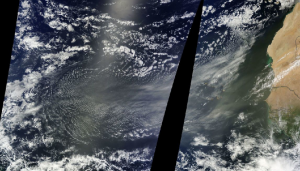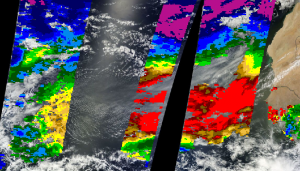Aerosol particles come in lots of different flavours and one of their most important properties is how they deal with incoming sunlight. Some are rather unwelcoming and send sunlight back to whence it came (space), which leads to a cooling of the atmosphere as the sunlight doesn’t reach the surface of the Earth. Others offer sunlight a warm(ing) embrace and absorb it, which heats up the atmosphere.
The relative amount of absorbing aerosol compared to the total aerosol burden in the atmosphere is the primary control on whether aerosol particles have a warming or cooling impact. Overall, aerosol particles are thought to cool climate but there are differences regionally and over the course of a typical year. We can see in the maps above that the absorbing aerosol is typically much smaller than the total amount of aerosol; the absorbing fraction is generally less than 5% of the total.
Regionally, the level of absorption and its relative contribution can be much larger, particularly where large-scale biomass burning occurs. Southern-West Africa sticks out in the above image where large-scale biomass burning occurs frequently. These open fires release large amounts of black carbon, which is the major absorbing aerosol species in the atmosphere. In addition, the fires can release so-called ‘brown carbon‘, which is a more weakly absorbing aerosol made up of organic material.
To complicate matters, biomass burning aerosol is also made up of the unaccommodating aerosols that scatter sunlight back to space. The competition between the scattering and absorbing aerosol species is quite intense and uncertain. The most recent Intergovernmental Panel on Climate Change (IPCC) report underlined our poor understanding of biomass burning aerosol, as its estimate of its impact didn’t pin down whether it cooled or warmed our atmosphere overall. The highlighted region over Southern-West Africa is a particularly complex and uncertain case.
Absorbing aerosol species are one of the hottest areas of research in aerosol science, as they have an uncertain contribution to climate warming (particularly on regional scales). Black carbon has received much attention on this front as a ‘short-lived climate forcer‘, plus there are significant health implications associated with it also. There are major questions relating to the impact of absorbing aerosol species on climate, which I will explore down the line on the blog and through my own research.
The dark side is clearly powerful. How powerful remains to be seen.
—————————————————————————————————————————————————————–
Multi-angle Imaging SpectroRadiometer (MISR) data was obtained from the NASA Langley Research Center Atmospheric Science Data Center.






